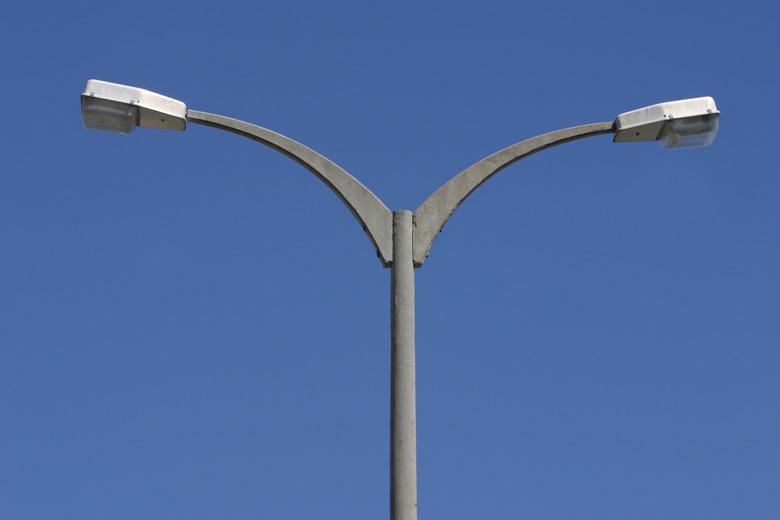LED Street Lights Vs. Metal Halide Lamps
Solid-state lighting with light-emitting diode, or LED, technology offers two primary advantages over incumbent lighting technologies: lower energy use and longer life. In many cases, those two advantages are enough to motivate the changeover from current lighting systems to LED fixtures. A few other characteristics differentiate specifically between LED and metal-halide (MH) lighting and factor into the decision to replace existing technology with new technology.
Light Color
Light Color
The mix of mercury vapor and metal halide molecules in an MH bulb emits a fairly uniform white color. There's a more-or-less standard blend of molecules, so the color you get from one MH bulb is pretty much the same as the color you get from any other. LED streetlights consist of a number of computer-chip-like elements that emit different wavelengths of light, depending upon their specific construction. In practice, one of the advantages of LED streetlights over other technologies — such as high-pressure sodium and mercury vapor lights — is their "white" light, so white LEDs are often chosen for streetlights.
There can be subtle differences in the quality of light from LED to LED, but their color is not all that distinct from each other, or from MH lights. In fact, Margaret Newman, the lighting professional leading New York City's conversion to LED streetlights, says that most people didn't even notice when Central Park's MH fixtures were replaced with LEDs.
Light Operation
Light Operation
MH fixtures produce light by sending electricity through a gas. Usually, gasses will not carry an electric current, so the first step is to ionize the gas within the bulb. That is, the first step is to separate electrons from their home atoms within the bulb. That could theoretically be done very quickly by providing a very rapid burst of high voltage, but that reduces the lifetime of the bulb. So a typical MH bulb will take about ten minutes to get to full operation. In contrast, LEDs emit light immediately in response to current flow, so there is no turn-on delay.
Light Distribution
Light Distribution
MH bulbs emit light in all directions, similar to the light distribution from an incandescent bulb. LEDs are designed on the chip package level to send their light in specific directions. Both MH and LED streetlights consist of the source and some optics — mirrors and lenses — that shape the light. Because LEDs offer more control over light distribution, less light is lost in the fixture. If you notice very even illumination between streetlights, you're probably looking at LEDs. Another LED advantage is that less light is sent up toward the sky, reducing both waste and light pollution.
Energy Use
Energy Use
MH bulbs need to be very bright because they don't distribute their light evenly, so to make sure there's enough light between poles, they need to start out extra bright. They also waste a fair amount of their light in the fixture, and they are less efficient than LEDs. Putting all those factors together can result in significant energy savings from LEDs. For example, the city of Pittsburgh, California, replaced 1,300 streetlights with LEDs and saved more than 500,000 kilowatt-hours and more than $65,000 in energy costs per year.
Cost and Maintenance
Cost and Maintenance
One area in which MH lamps have an advantage is in initial cost. An MH bulb can cost in the range of $20 to $50 or so, while the least expensive LED fixture will cost you at least $100. But one LED fixture can last as long as 20 or more MH bulbs. When you factor in the cost of maintenance — which can be very high, even when you don't need to shut down roadways for bulb replacement — an LED replacement program can pay for itself in just a few years.
Cite This Article
MLA
Gaughan, Richard. "LED Street Lights Vs. Metal Halide Lamps" sciencing.com, https://www.sciencing.com/led-street-lights-vs-metal-halide-lamps-24029/. 24 April 2017.
APA
Gaughan, Richard. (2017, April 24). LED Street Lights Vs. Metal Halide Lamps. sciencing.com. Retrieved from https://www.sciencing.com/led-street-lights-vs-metal-halide-lamps-24029/
Chicago
Gaughan, Richard. LED Street Lights Vs. Metal Halide Lamps last modified March 24, 2022. https://www.sciencing.com/led-street-lights-vs-metal-halide-lamps-24029/
